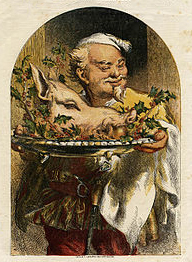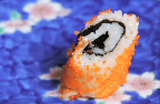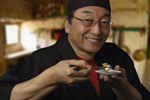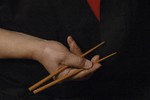 As they used to say at the beginning of every Monty Python episode: “And now for something completely different…”
As they used to say at the beginning of every Monty Python episode: “And now for something completely different…”
You might need the intelligence and humor of a Python to fully understand the inventive, arcane, and fanciful dishes popular in the British Isles:
1. “Bubble and Squeak” [This one’s not so bad: just pan-fried potatoes and veggies.]
2. “Love In Disguise” [Stuffed calf’s heart. Yeah, “a rose by any other name” is still one pretty messed-up culinary concept!]
3. “Cullen Skink” [Haddock and potato soup. This one sounds quite good.]
4. “Star-Gazey Pie” [A fish pie with fish heads poking up through the crust!]
5. “Toad in a Hole” [Sausages in Yorkshire Pudding. Weird name. Sounds good.]
6. “Spotted Dick” [Yeeesh! Now you’re just pulling my leg!]
7. “Haggis” [Uggg! Don’t even ask!]
Which leads to an enduring dish of the Christmas Season, still celebrated with much pomp in Britain: “The Boar’s Head.” I’ve heard the carol many times and wondered at this odd dish, considered “the rarest dish in all the land” but I certainly never thought I would actually meet someone who has not only tasted it, but has prepared it…and that that person would be an American!
 Wild boar has been considered a delicacy throughout the ages. The Romans served it first at their banquets. The Norse sacrificed boar at the Winter’s Solstice (December 21st) to gain favor from their sun-god, Freyr. The Celts revered the boar as a gift from the Otherworld and at their feasts. Celtic warriors would compete over the choice parts of the boar. The best example of this in Irish literature being “Bricriu’s Feast.” That choice part was most well deserved. One needed the courage and strength of a warrior to even attempt to bring down a hundred pound-plus of an intelligent, pissed-off, muscled and tusked monster in the wild!
Wild boar has been considered a delicacy throughout the ages. The Romans served it first at their banquets. The Norse sacrificed boar at the Winter’s Solstice (December 21st) to gain favor from their sun-god, Freyr. The Celts revered the boar as a gift from the Otherworld and at their feasts. Celtic warriors would compete over the choice parts of the boar. The best example of this in Irish literature being “Bricriu’s Feast.” That choice part was most well deserved. One needed the courage and strength of a warrior to even attempt to bring down a hundred pound-plus of an intelligent, pissed-off, muscled and tusked monster in the wild!
In addition to emotional fortitude, one tool needed for a boar hunt was a boar’s pike. This was usually made of a short-ish and thick staff of ash or oak, capped at the bottom with a short metal spike and topped with a longer pike with the most important part: a strong metal crossbeam. The trick then was to find and corner the boar and (providing you could stand your ground) the boar would do all the work. As the tusked behemoth charged, you planted the bottom of the pike into the ground and leveled it at the boar’s chest. The boar would run himself through the pike trying to get at you! The crossbeam (usually) stopped the boar’s charge and prevented him from running straight up the shaft and skewering YOU with his tusks, instead!
Being a vegetarian for some years, getting carnivores to talk about the odd meat dishes they’ve had, is bit like going to see a horror movie or a having a near-miss on the freeway for me: I know I’m ultimately safe, but the rush remains! It was a recent discussion about “favorite organ dishes” with the owner of my company, Jim, that I was surprised that his immediate answer was “Boar’s Head!” From previous discussions about food with Jim, I understood him to have a very adventuresome, but discriminating palate, so I trusted his opinion.
 Jim had boar’s head years ago, as an English student attending college in Buffalo, NY. Close to Christmas, a British exchange-student, knowing Jim had a culinary talent, asked him to help prepare a boar’s head for a Christmas party. As boar is unheard of in America, they settled for a pig’s head from the butchers, and started the laborious (three hours worth) process of preparation. First they soaked the head in warm water to loosen the skin of the head. They carefully made a short incision at the back and peeled the skin off. They then removed the brain, eyes, and tongue of the beast for later. In a large pot they added boiling water to the skull to further remove any remaining meat and discarded the skull.
Jim had boar’s head years ago, as an English student attending college in Buffalo, NY. Close to Christmas, a British exchange-student, knowing Jim had a culinary talent, asked him to help prepare a boar’s head for a Christmas party. As boar is unheard of in America, they settled for a pig’s head from the butchers, and started the laborious (three hours worth) process of preparation. First they soaked the head in warm water to loosen the skin of the head. They carefully made a short incision at the back and peeled the skin off. They then removed the brain, eyes, and tongue of the beast for later. In a large pot they added boiling water to the skull to further remove any remaining meat and discarded the skull.
Now that they had all the meat, they chopped it all up (yes ALL…brains, eyes, tongue…the works) and added pork butt to extend the meat from the head. Added to the meat was stock, beaten eggs, leeks, onions, mincemeat, celery and spices (sage, thyme, and probably bay.) To extend the stuffing further, they added cooked rice (Jim pointed out that bread would have been more traditional.)
Next, was reassembling of the head, putting the stuffing back into the “pig’s mask.” This, Jim says, was definitely a two-person job: one to hold the head together, another load the stuffing in and to stitch the back with butcher’s twine and a bone needle. Once assembled, the ears were covered with foil, the head was glazed with a jam or cherry sauce and the whole thing baked for several hours until the skin was crisp. As decoration, whole parsnips were placed in the mouth as tusks and cherries for the eyes, an effect Jim says was “demonic.”
 Jim told me that Boar’s Head is served with the main course, not as the main course, so would’ve traditionally been served with a roast (beef, goose, or turkey) on a silver platter surrounded by candied root veggies and greens (traditionally evergreens, bay, rosemary, and holly.) Boar’s Head is usually served with a gravy or hunter’s glaze.
Jim told me that Boar’s Head is served with the main course, not as the main course, so would’ve traditionally been served with a roast (beef, goose, or turkey) on a silver platter surrounded by candied root veggies and greens (traditionally evergreens, bay, rosemary, and holly.) Boar’s Head is usually served with a gravy or hunter’s glaze.
This being college, the boar’s head was served with much liquid Christmas cheer, and being Buffalo, also with the ubiquitous “Suicide Chicken Wings.” Jim says the students “attacked” the dish with relish, but when asked about the whole process, he summed it up nicely, “Ah…not for the faint of heart.”




































